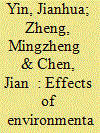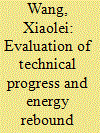|
|
|
Sort Order |
|
|
|
Items / Page
|
|
|
|
|
|
|
| Srl | Item |
| 1 |
ID:
137694


|
|
|
|
|
| Summary/Abstract |
Based on environmental Kuznets curve theory, a panel data model which takes environmental regulation and technical progress as its moderating factors was developed to analyse the institutional and technical factors that affect the path of low-carbon economic development. The results indicated that there was a CO2 emission Kuznets curve seen in China. Environmental regulation had a significant moderating effect on the curve, and the inflection of CO2 emissions could come substantially earlier under stricter environmental regulation. Meanwhile, the impact of technical progress on the low-carbon economic development path had a longer hysteresis effect but restrained CO2 emission during its increasing stage and accelerated its downward trend during the decreasing stage which was conducive to emission reduction. Strict environmental regulation could force the high-carbon emitting industries to transfer from the eastern regions to the central or the western regions of China, which would make the CO2 Kuznets curve higher in its increasing stage and lower in its decreasing stage than that under looser regulation. Furthermore, energy efficiency, energy structure, and industrial structure exerted a significant direct impact on CO2 emissions; we should consider the above factors as essential in the quest for low-carbon economic development.
|
|
|
|
|
|
|
|
|
|
|
|
|
|
|
|
| 2 |
ID:
162282


|
|
|
|
|
| Summary/Abstract |
As a pillar industry in China, the iron & steel sector have under through rapid growth and technical progress for decades. However, energy polices aiming at energy savings may not be as good as expected due to the existence of rebound effects. The motivation of the paper is to analysis the nexus between technical progress and energy rebound effects. Based on a three-input trans-log cost function model, we first estimate the share equation and the corresponding price elasticity for each input factor. Then, the rebound effect in China's iron & steel industry over 1985–2015 is evaluated through decomposing the energy prices. Empirical results show that: (1) The price elasticities of input factors are negative; (2) Energy/capital and energy/labor show substitute relationships; (3) The average energy rebound effect in the ISI is as high as 73.88%; (4) The energy rebound effect shows a downward trend before the 11th Five-year period and then an upward trend after that. Therefore, policies proposals of lowering the rebound effect should be placed not only on technical progress, but also on energy price reform by reducing energy subsidies and thus accelerating energy price marketization, so as to promote energy substitution, reduce energy rebound effect and produce further economic and environmental benefits.
|
|
|
|
|
|
|
|
|
|
|
|
|
|
|
|
| 3 |
ID:
121338


|
|
|
|
|
| Publication |
2013.
|
| Summary/Abstract |
Using provincial panel data from the period 1995-2009 to analyze the relationship between the industrial structural transformation and carbon dioxide emissions in China, we find that the first-order lag of industrial structural adjustment effectively reduced the emissions; technical progress itself did not reduce the emissions, but indirectly led to decreasing emissions through the upgrading and optimization of industrial structure. Foreign direct investment and intervention by local governments reduced carbon dioxide emissions, but urbanization significantly increased the emissions. Thus, industrial structural adjustment is an important component of the development of a low-carbon economy. In the context of industrial structural transformation, an effective way to reduce a region's carbon dioxide emissions is to promote the upgrading and optimization of industrial structure through technical progress. Tighter environmental access policies, selective utilization of foreign direct investment, and improvements in energy efficiency can help to reduce carbon dioxide emissions.
|
|
|
|
|
|
|
|
|
|
|
|
|
|
|
|
| 4 |
ID:
092427


|
|
|
|
|
| Publication |
2009.
|
| Summary/Abstract |
The Chinese life-insurance industry has experienced major structural changes in recent years, primarily because of increasing demand and the entry of foreign insurers. Although the market is clearly booming, the efficiency of its growth and development is unclear. In this paper, we evaluate the efficiency of life insurers operating in China and compare foreign firms with domestic firms. We find that foreign insurers have not brought efficiency into the Chinese market, and that the market is still dominated by domestic giants. However, the gap between foreign insurers and domestic insurers is narrowing. After testing hypotheses regarding scale economy, technical progress and potential improvements, we discuss several issues of importance to life insurers, market investors and government regulators.
|
|
|
|
|
|
|
|
|
|
|
|
|
|
|
|
|
|
|
|
|